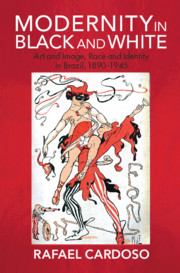Book contents
- Modernity in Black and White
- Afro-Latin America
- Modernity in Black and White
- Copyright page
- Dedication
- Epigraph
- Contents
- Figures
- Acknowledgements
- Notes on Usage of Brazilian Portuguese
- Introduction
- 1 Heart of Darkness in the Bosom of the Modern Metropolis
- 2 A Pagan Festival for the Up to Date
- 3 The Printing of Modern Life
- 4 The Cosmopolitan Savage
- 5 The Face of the Land
- Epilogue
- Index
Introduction
Ambiguous Modernities and Alternate Modernisms
Published online by Cambridge University Press: 06 April 2021
- Modernity in Black and White
- Afro-Latin America
- Modernity in Black and White
- Copyright page
- Dedication
- Epigraph
- Contents
- Figures
- Acknowledgements
- Notes on Usage of Brazilian Portuguese
- Introduction
- 1 Heart of Darkness in the Bosom of the Modern Metropolis
- 2 A Pagan Festival for the Up to Date
- 3 The Printing of Modern Life
- 4 The Cosmopolitan Savage
- 5 The Face of the Land
- Epilogue
- Index
Summary
The prevailing paradigm of modern art in Brazil still revolves around the Modern Art Week of 1922, in São Paulo, and the self-professed avant-gardes that derived from that event. What came immediately before it is usually relegated to a limbo status, as neither modern nor non-modern. The introduction casts doubt upon the widely accepted category pre-modernism, questioning its validity as a historical construct. Evidence demonstrates that alternate modernisms existed in the Brazilian context prior to 1922. Chief among these is a variant of modernism linked to the rising urban culture of music, dance, theatre, humour, graphics and cinema in Rio de Janeiro. The relative lack of scholarly interest in mass culture has led to a tendency to overstate the impact of erudite expressions in literature, fine art and architecture. Other arenas of cultural production have been systematically overlooked, including ones to which Afro-Brazilian artists made important contributions. This skewed perspective subtly elides how elite practitioners often appropriated subaltern identities to reinforce their own claims to modernity, vis-à-vis their European counterparts. The book proposes to examine the conflicts between primitivism and nationalism, modernism and archaism. Rethinking these tensions in the Brazilian context helps make sense of divergent models of modernism elsewhere.
Keywords
- Type
- Chapter
- Information
- Modernity in Black and WhiteArt and Image, Race and Identity in Brazil, 1890–1945, pp. 1 - 25Publisher: Cambridge University PressPrint publication year: 2021

